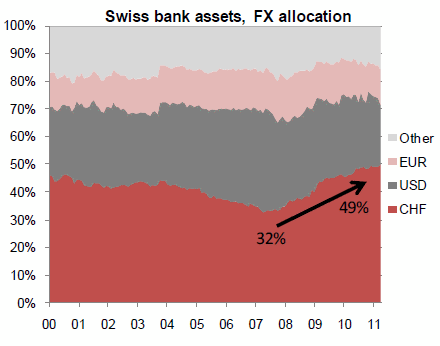The total size of Swiss bank balance sheets has stabilized over the past 18 months, according to Swiss National Bank data, suggesting that new capital requirements are dampening demand for leverage. Lower leverage levels imply reduced amounts of foreign assets, Nomura said, because previous high leverage levels were driven by foreign currency holdings.
In addition, the proportion of Swiss bank assets held in Swiss francs has increased since the financial crisis to 49%, compared with 32% previously, national bank data published on Tuesday showed, while the share held in dollars has fallen to 21%, the lowest level since 1999.
Rising balance sheets and increased foreign currency holdings, alongside the trade balance, were indicated by Nomura in May as the key signposts for a possible decline in the Swiss franc. Given that today’s central bank data shows two of those variables are not satisfied (with trade balance numbers due on Thursday), there was no reason to believe the franc will sell off any time soon, Nomura said in a note.
The actions of Swiss banks have been a major driver of Swiss franc strength, Nomura said. That was indicated by analysis showing that the currency performed best during European trading hours.
While bank asset flows were probably the most important indicator for the franc (given the size of the banking sector), trade flows were also germane.
Analysts are “puzzled” by how resilient Swiss exports have been, given the currency’s strength. It may be that exporters are carrying the loss, they say, suggesting that the impact will be felt eventually.
“Such a deterioration in exports would probably reduce the upward pressure on the CHF and could lead to a turn in the CHF,” Nomura said.
| Nomura research: Swiss bank asset currency mix |
|
|
| Source: SNB, Nomura |
